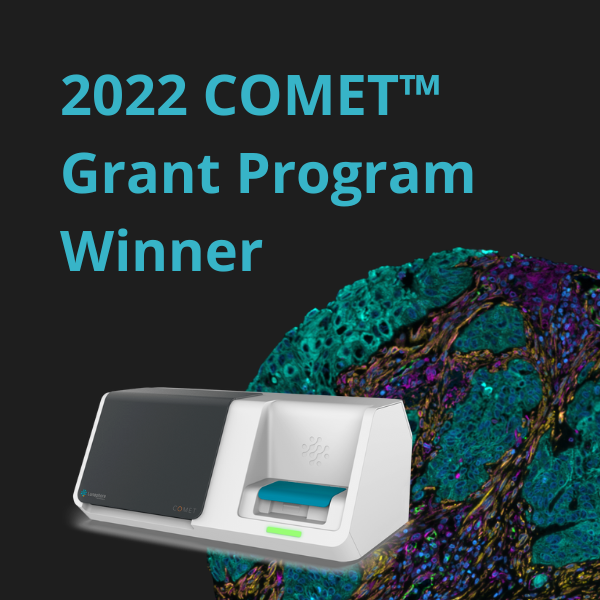news
Lunaphore announces the winner of the 2022 COMET™ Grant Program
Date

LAUSANNE, Switzerland – December 20, 2022 – 3:00 pm (CET) – Lunaphore, a Swiss life sciences company developing technology to enable spatial biology in every laboratory, today announced Dr. Monika Golinska of the Cancer Research UK Cambridge Institute as the winner of the 2022 COMET™ Grant Program. The Program was designed to advance spatial biology research by awarding a four-month COMET™ instrument placement. COMET™ is a fully automated sequential immunofluorescence (seqIF™) instrument that performs high-throughput hyperplex spatial biology analysis on tissue samples using standard, non-conjugated antibodies and enables simultaneous analysis of 40 different spatial markers per tissue slide without user intervention. The research team will use the instrument to advance the understanding of tumor evolution, immune ecotypes, and tumor vasculature using innovative, next-generation imaging sciences in breast and ovarian cancer.
The 2022 COMET™ Grant Program received a significant number of outstanding applications. The technology placement was awarded to the best project based on its scientific impact and technology fit, including a project hypothesis detailing how COMET™ will be used in the scope of a multiplex immunofluorescence project. The instrument placement will take place in early 2023.
GRANT WINNER
Cancer Research UK Cambridge Institute, Vision Lab /Bohndiek Lab
Project title: Determining tumor vasculature maturity and immune ecotypes in breast and ovarian cancer
Project leader: Dr. Monika Golinska
Project description:
Dr. Monika Golinska’s project will investigate how vascular network formation impacts tumor growth, oxygenation, metabolism, and treatment response. For this purpose, in vivo photoacoustic imaging techniques will be used to deconvolute the complex tumor microenvironment. The project will focus its efforts on understanding how different radiotherapy regimes impact vascular composition and treatment response in luminal and triple-negative breast cancer subtypes. Moreover, in collaboration with Prof. James Brenton’s team at the Institute, the group will also examine ecological distinctions between clinically relevant subgroups of human high-grade serous ovarian carcinoma from the Translational Cancer Research Ovarian Study 04 (CTCROV04).
The inclusion of COMET™ in the project aims to integrate an ex vivo modality that allows spatial mapping of the molecular mechanisms underpinning these changes in vascular and immune function by spatially correlating multiple vascular, immune, and metabolic markers in a single tissue section. This correlation could reveal the diversity of cellular interactions, enabling the researchers to infer the effect of an intervention. With this study, uncovering critical biological insights could open up avenues of data analysis and facilitate the in-depth search for spatial correlations.
Lunaphore would like to thank all the applicants for their strong interest in this Program and the excellent quality of the projects submitted. The Program will incentivize data generation more broadly as well as lower the barriers to spatial technology adoption in support of bringing awareness to the latest research and innovation leading the spatial biology field.
To learn more about Lunaphore, please visit: www.lunaphore.com
About Lunaphore
Lunaphore Technologies S.A. is a Swiss company born in 2014 with the vision of enabling spatial biology in every laboratory. Lunaphore provides solutions based on a game-changing chip technology that can extract spatial proteomic and transcriptomic data from tumors and other tissues, transforming any assay into multiplex spatial biology with an intuitive approach. Lunaphore empowers researchers in immunology, immuno-oncology, and neuroscience to push the boundaries of scientific discovery and drug development. Lunaphore’s technology enables the identification of biomarker “signatures” with clinical relevance to support the development of diagnostic tools and streamline clinical trials, to ultimately improve patient outcomes. For further information on Lunaphore and its products, please visit: www.lunaphore.com
About COMET™
COMET™ is a fully automated, sequential immunofluorescence (seqIF™) instrument, able to perform hyperplex staining and imaging, producing high-quality data in a robust and reproducible manner. With superior tissue profiling capabilities, the system allows multiplex analysis of up to 40 different spatial markers per tissue slide without human intervention. COMET™ has a wide range of research applications, allowing for a dramatic improvement in the understanding of disease pathology in areas such as immuno-oncology, neuroscience, and infectious diseases. To learn more about the COMET™ platform, please visit: https://lunaphore.com/products/comet/
For further information contact: Irene Tamayo
Lunaphore Corporate Communications Email: [email protected]